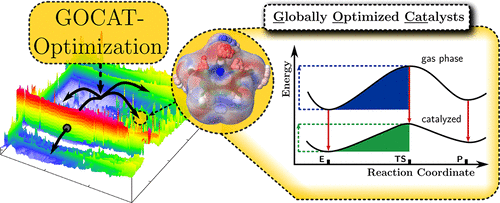当前位置:
X-MOL 学术
›
J. Chem. Theory Comput.
›
论文详情
Our official English website, www.x-mol.net, welcomes your feedback! (Note: you will need to create a separate account there.)
Globally Optimal Catalytic Fields – Inverse Design of Abstract Embeddings for Maximum Reaction Rate Acceleration
Journal of Chemical Theory and Computation ( IF 5.5 ) Pub Date : 2018-06-08 00:00:00 , DOI: 10.1021/acs.jctc.8b00151 Mark Dittner 1 , Bernd Hartke 1
Journal of Chemical Theory and Computation ( IF 5.5 ) Pub Date : 2018-06-08 00:00:00 , DOI: 10.1021/acs.jctc.8b00151 Mark Dittner 1 , Bernd Hartke 1
Affiliation

|
The search for, and understanding of, good catalysts for chemical reactions is a central issue for chemists. Here, we present first steps toward developing a general computational framework to better support this task. This framework combines efficient, unbiased global optimization techniques with an abstract representation of the catalytic environment, to shrink the search space. To analyze the resulting catalytic embeddings, we employ dimensionality reduction and clustering techniques. This not only provides an inverse design approach to new catalytic embeddings but also illuminates the actual interactions behind catalytic effects. All this is illustrated here with a strictly electrostatic model for the environment and with two versions of a selected example reaction. We close with detailed discussions of future improvements of our framework.
中文翻译:

全局最佳催化场–为最大反应速率加速而抽象嵌入的逆向设计
寻找和理解用于化学反应的良好催化剂是化学家的中心问题。在这里,我们介绍了开发通用计算框架以更好地支持此任务的第一步。该框架将高效,无偏的全局优化技术与催化环境的抽象表示相结合,以缩小搜索空间。为了分析最终的催化嵌入,我们采用了降维和聚类技术。这不仅为新的催化嵌入物提供了一种逆向设计方法,而且还阐明了催化作用背后的实际相互作用。此处使用严格的静电模型针对环境以及所选示例反应的两个版本进行了说明。我们以对框架的未来改进的详细讨论作为结束。
更新日期:2018-06-08
中文翻译:

全局最佳催化场–为最大反应速率加速而抽象嵌入的逆向设计
寻找和理解用于化学反应的良好催化剂是化学家的中心问题。在这里,我们介绍了开发通用计算框架以更好地支持此任务的第一步。该框架将高效,无偏的全局优化技术与催化环境的抽象表示相结合,以缩小搜索空间。为了分析最终的催化嵌入,我们采用了降维和聚类技术。这不仅为新的催化嵌入物提供了一种逆向设计方法,而且还阐明了催化作用背后的实际相互作用。此处使用严格的静电模型针对环境以及所选示例反应的两个版本进行了说明。我们以对框架的未来改进的详细讨论作为结束。



























 京公网安备 11010802027423号
京公网安备 11010802027423号